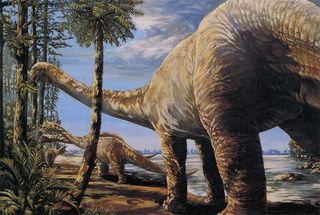Key to Success? Dinosaurs May Have Been Warm-Blooded

Many dinosaurs may have been warm-blooded just like mammals or birds, potentially explaining their extraordinary success before their extinction.
For decades, scientists assumed that because dinosaurs resembled lizards, they were cold-blooded as well, their internal temperature rising and falling with the outside world. However, birds are warm-blooded, and the fact that birds seem to be descended from dinosaurs raises the question of whether their ancestors were as well.
If dinosaurs were warm-blooded, they would have possessed the potential for athletic abilities rivaling those of mammals and birds. They could have survived in colder habitats that would kill cold-blooded creatures, such as high mountain ranges and polar regions, enabling them to cover the entire landscape. Such advantages do carry a price — warm-blooded animals need much more food than their cold-blooded counterparts because their rapid metabolisms fatally malfunction if they cool down too much from lack of fuel.
To investigate whether dinosaurs were warm-blooded, researchers sought to infer how much energy they used. For instance, if walking and running burned more energy than a cold-blooded metabolism can supply, dinosaurs were probably warm-blooded.
Past research suggested the energy cost of walking and running is strongly linked with leg length, so much so that hip height — the distance from the hip joint to the ground — can predict the energy cost of locomotion with 98 percent accuracy for a wide variety of land animals. Since hip height can be simply estimated from the length of fossilized leg bones, scientists were able to obtain simple but reliable estimates of energy costs for dinosaur locomotion.
To back up these estimates, the researchers also estimated the actual amount of leg muscle dinosaurs would need to activate in order to move. Doing so with extinct animals involved using basic principles of locomotion — analyzing how large the forces required from the legs would have to be to move the animal and how much muscle would be needed to supply these forces.
After investigating anatomical models of 13 extinct dinosaur species, both the methods the scientists employed suggest at least five of them, and perhaps all of them, were probably warm-blooded athletic animals, because their energy requirements during walking and running were too high for cold-blooded animals to generate.
Sign up for the Live Science daily newsletter now
Get the world’s most fascinating discoveries delivered straight to your inbox.
Interestingly, when the results for each dinosaur were arranged into an evolutionary family tree, the researchers found warm-bloodedness might have been present among the most ancient dinosaurs, suggesting it might be the ancestral condition for all dinosaurs. This could be one of the key factors in the massive success that dinosaurs enjoyed for more than 160 million years, the researchers noted.
"My work examines how differences in limb anatomy lead to differences in the energy cost of walking and running," said researcher Herman Pontzer, a biomechanist at Washington University in St. Louis. "As we get better at understanding these fundamental relationships, we'll be able to extract more and more information about the physiology and life of extinct species, just from analyzing their skeletons. We'll be able to know more and more about how they lived, not just what they looked like."
The scientists detailed their findings online November 10 in the journal PLoS ONE.
- 25 Amazing Ancient Beasts
- Image Gallery: Dinosaur Fossils
- Dinosaur News & Images

